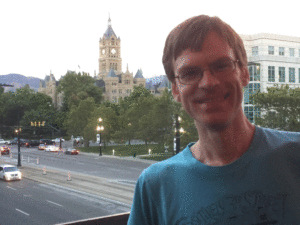Strategies for Probing the Dark Side of the Universe
 Brooks Thomas, assistant professor of physics, and his collaborators Keith R. Dienes, Doojin Kim, Huayang Song, Shufang Su, and David Yaylali published the article “Nonminimal dark sectors: Mediator-induced decay chains and multijet collider signatures” in April in Physical Review.
Brooks Thomas, assistant professor of physics, and his collaborators Keith R. Dienes, Doojin Kim, Huayang Song, Shufang Su, and David Yaylali published the article “Nonminimal dark sectors: Mediator-induced decay chains and multijet collider signatures” in April in Physical Review.
Thomas explains, “One of the triumphs of contemporary physics is that we now have a very consistent picture of the fundamental particles that make up normal, atomic matter and the forces through which these particles interact—a picture which has become known as the Standard Model of particle physics. However, there is a lot of evidence (mostly from astrophysical observations) that our universe also contains other kinds of particles as well—particles that are ‘dark’ in the sense that they interact only very weakly with the more familiar particles of the Standard Model.
 “We don’t yet know how many different kinds of dark particles exist in our universe or how those particles might interact with those more familiar, visible particles. One interesting possibility is that the dark particles might interact with visible particles by exchanging another kind of particle—a heavy, hypothetical particle called a mediator. The reason this possibility is interesting is that the mediator could provide a ‘portal’ of sorts between the visible and dark particles in our universe, potentially allowing us to produce dark particles by colliding familiar particles together.
“We don’t yet know how many different kinds of dark particles exist in our universe or how those particles might interact with those more familiar, visible particles. One interesting possibility is that the dark particles might interact with visible particles by exchanging another kind of particle—a heavy, hypothetical particle called a mediator. The reason this possibility is interesting is that the mediator could provide a ‘portal’ of sorts between the visible and dark particles in our universe, potentially allowing us to produce dark particles by colliding familiar particles together.
“In our recent paper, my collaborators and I make a simple but potentially important observation: If there are many different kinds or species of dark particle that interact with the same mediator, not only does the mediator provide us with a way of producing dark particles at experiments, but it also causes the dark particles to decay. This means that whenever we produce a heavy dark particle, that particle will rapidly decay, producing both some visible particles and one or more other, lighter dark particles. These lighter dark particles will then themselves decay, producing more visible particles and other, even lighter dark particles, and so on. If the number of individual decay steps in this process is large, a vast number of visible particles can be produced. ‘Decay cascades’ of this sort can therefore lead to striking signals at experiments!
 “Does such a panoply of dark particles really exist in nature? Do they really interact with visible particles through such a mediator? We don’t know, but we’d like to find out. Our goal in this paper was to determine whether these decay cascades could potentially be detected at the Large Hadron Collider (LHC), the particle-physics experiment in Switzerland at which the Higgs boson was recently discovered. We showed that indeed, in many cases, these signals would not have been observed at the LHC thus far, but would be within reach in the future as the LHC accumulates more and more data. This is exciting since it means that there could potentially be new discoveries beyond the Higgs boson still awaiting us at the LHC.”
“Does such a panoply of dark particles really exist in nature? Do they really interact with visible particles through such a mediator? We don’t know, but we’d like to find out. Our goal in this paper was to determine whether these decay cascades could potentially be detected at the Large Hadron Collider (LHC), the particle-physics experiment in Switzerland at which the Higgs boson was recently discovered. We showed that indeed, in many cases, these signals would not have been observed at the LHC thus far, but would be within reach in the future as the LHC accumulates more and more data. This is exciting since it means that there could potentially be new discoveries beyond the Higgs boson still awaiting us at the LHC.”
Leave a Reply